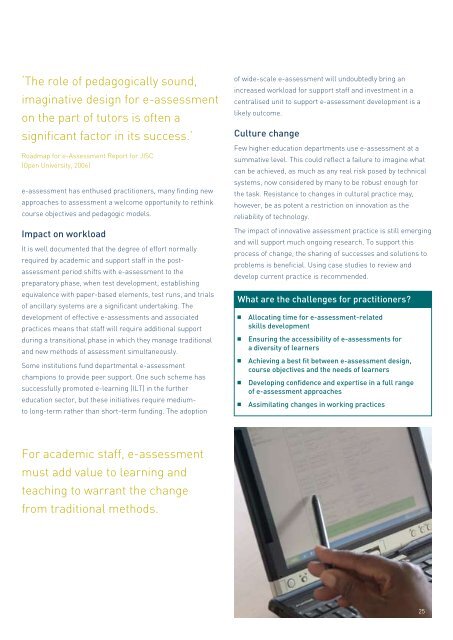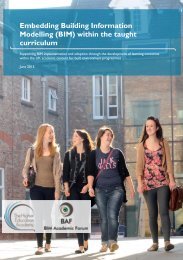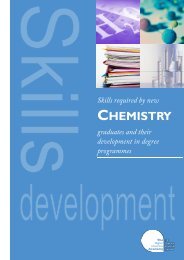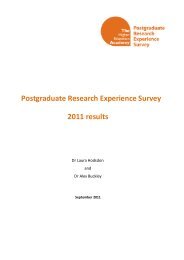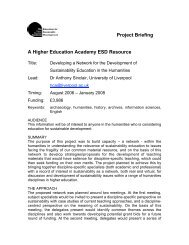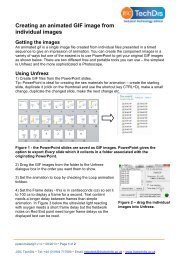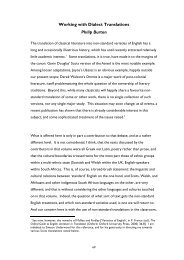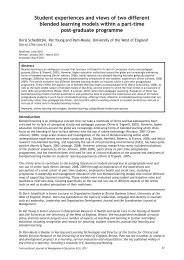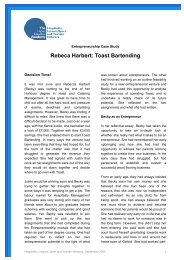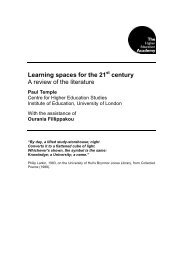Effective Practice with e-Assessment: An overview of ... - Jisc
Effective Practice with e-Assessment: An overview of ... - Jisc
Effective Practice with e-Assessment: An overview of ... - Jisc
You also want an ePaper? Increase the reach of your titles
YUMPU automatically turns print PDFs into web optimized ePapers that Google loves.
‘The role <strong>of</strong> pedagogically sound,<br />
imaginative design for e-assessment<br />
on the part <strong>of</strong> tutors is <strong>of</strong>ten a<br />
significant factor in its success.’<br />
Roadmap for e-<strong>Assessment</strong> Report for JISC<br />
(Open University, 2006)<br />
e-assessment has enthused practitioners, many finding new<br />
approaches to assessment a welcome opportunity to rethink<br />
course objectives and pedagogic models.<br />
Impact on workload<br />
It is well documented that the degree <strong>of</strong> effort normally<br />
required by academic and support staff in the postassessment<br />
period shifts <strong>with</strong> e-assessment to the<br />
preparatory phase, when test development, establishing<br />
equivalence <strong>with</strong> paper-based elements, test runs, and trials<br />
<strong>of</strong> ancillary systems are a significant undertaking. The<br />
development <strong>of</strong> effective e-assessments and associated<br />
practices means that staff will require additional support<br />
during a transitional phase in which they manage traditional<br />
and new methods <strong>of</strong> assessment simultaneously.<br />
Some institutions fund departmental e-assessment<br />
champions to provide peer support. One such scheme has<br />
successfully promoted e-learning (ILT) in the further<br />
education sector, but these initiatives require medium-<br />
to long-term rather than short-term funding. The adoption<br />
<strong>of</strong> wide-scale e-assessment will undoubtedly bring an<br />
increased workload for support staff and investment in a<br />
centralised unit to support e-assessment development is a<br />
likely outcome.<br />
Culture change<br />
Few higher education departments use e-assessment at a<br />
summative level. This could reflect a failure to imagine what<br />
can be achieved, as much as any real risk posed by technical<br />
systems, now considered by many to be robust enough for<br />
the task. Resistance to changes in cultural practice may,<br />
however, be as potent a restriction on innovation as the<br />
reliability <strong>of</strong> technology.<br />
The impact <strong>of</strong> innovative assessment practice is still emerging<br />
and will support much ongoing research. To support this<br />
process <strong>of</strong> change, the sharing <strong>of</strong> successes and solutions to<br />
problems is beneficial. Using case studies to review and<br />
develop current practice is recommended.<br />
What are the challenges for practitioners?<br />
g<br />
Allocating time for e-assessment-related<br />
skills development<br />
g<br />
g<br />
g<br />
g<br />
Ensuring the accessibility <strong>of</strong> e-assessments for<br />
a diversity <strong>of</strong> learners<br />
Achieving a best fit between e-assessment design,<br />
course objectives and the needs <strong>of</strong> learners<br />
Developing confidence and expertise in a full range<br />
<strong>of</strong> e-assessment approaches<br />
Assimilating changes in working practices<br />
For academic staff, e-assessment<br />
must add value to learning and<br />
teaching to warrant the change<br />
from traditional methods.<br />
25


